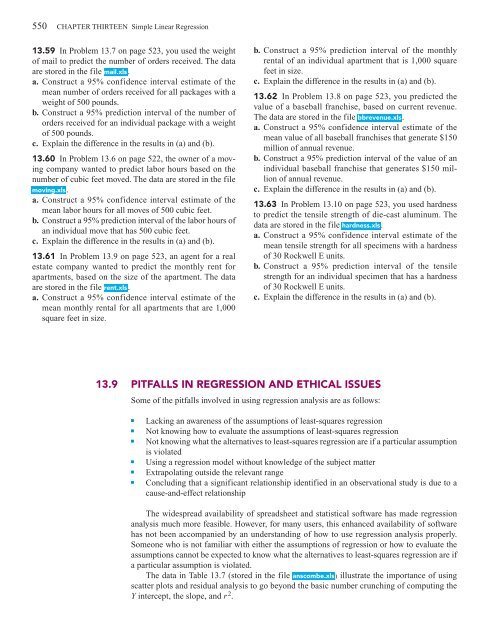CHAPTER 13 Simple Linear Regression
CHAPTER 13 Simple Linear Regression
CHAPTER 13 Simple Linear Regression
You also want an ePaper? Increase the reach of your titles
YUMPU automatically turns print PDFs into web optimized ePapers that Google loves.
550 <strong>CHAPTER</strong> THIRTEEN <strong>Simple</strong> <strong>Linear</strong> <strong>Regression</strong><br />
<strong>13</strong>.59 In Problem <strong>13</strong>.7 on page 523, you used the weight<br />
of mail to predict the number of orders received. The data<br />
are stored in the file mail.xls.<br />
a. Construct a 95% confidence interval estimate of the<br />
mean number of orders received for all packages with a<br />
weight of 500 pounds.<br />
b. Construct a 95% prediction interval of the number of<br />
orders received for an individual package with a weight<br />
of 500 pounds.<br />
c. Explain the difference in the results in (a) and (b).<br />
<strong>13</strong>.60 In Problem <strong>13</strong>.6 on page 522, the owner of a moving<br />
company wanted to predict labor hours based on the<br />
number of cubic feet moved. The data are stored in the file<br />
moving.xls.<br />
a. Construct a 95% confidence interval estimate of the<br />
mean labor hours for all moves of 500 cubic feet.<br />
b. Construct a 95% prediction interval of the labor hours of<br />
an individual move that has 500 cubic feet.<br />
c. Explain the difference in the results in (a) and (b).<br />
<strong>13</strong>.61 In Problem <strong>13</strong>.9 on page 523, an agent for a real<br />
estate company wanted to predict the monthly rent for<br />
apartments, based on the size of the apartment. The data<br />
are stored in the file rent.xls.<br />
a. Construct a 95% confidence interval estimate of the<br />
mean monthly rental for all apartments that are 1,000<br />
square feet in size.<br />
b. Construct a 95% prediction interval of the monthly<br />
rental of an individual apartment that is 1,000 square<br />
feet in size.<br />
c. Explain the difference in the results in (a) and (b).<br />
<strong>13</strong>.62 In Problem <strong>13</strong>.8 on page 523, you predicted the<br />
value of a baseball franchise, based on current revenue.<br />
The data are stored in the file bbrevenue.xls.<br />
a. Construct a 95% confidence interval estimate of the<br />
mean value of all baseball franchises that generate $150<br />
million of annual revenue.<br />
b. Construct a 95% prediction interval of the value of an<br />
individual baseball franchise that generates $150 million<br />
of annual revenue.<br />
c. Explain the difference in the results in (a) and (b).<br />
<strong>13</strong>.63 In Problem <strong>13</strong>.10 on page 523, you used hardness<br />
to predict the tensile strength of die-cast aluminum. The<br />
data are stored in the file hardness.xls.<br />
a. Construct a 95% confidence interval estimate of the<br />
mean tensile strength for all specimens with a hardness<br />
of 30 Rockwell E units.<br />
b. Construct a 95% prediction interval of the tensile<br />
strength for an individual specimen that has a hardness<br />
of 30 Rockwell E units.<br />
c. Explain the difference in the results in (a) and (b).<br />
<strong>13</strong>.9 PITFALLS IN REGRESSION AND ETHICAL ISSUES<br />
Some of the pitfalls involved in using regression analysis are as follows:<br />
■<br />
■<br />
■<br />
■<br />
■<br />
■<br />
Lacking an awareness of the assumptions of least-squares regression<br />
Not knowing how to evaluate the assumptions of least-squares regression<br />
Not knowing what the alternatives to least-squares regression are if a particular assumption<br />
is violated<br />
Using a regression model without knowledge of the subject matter<br />
Extrapolating outside the relevant range<br />
Concluding that a significant relationship identified in an observational study is due to a<br />
cause-and-effect relationship<br />
The widespread availability of spreadsheet and statistical software has made regression<br />
analysis much more feasible. However, for many users, this enhanced availability of software<br />
has not been accompanied by an understanding of how to use regression analysis properly.<br />
Someone who is not familiar with either the assumptions of regression or how to evaluate the<br />
assumptions cannot be expected to know what the alternatives to least-squares regression are if<br />
a particular assumption is violated.<br />
The data in Table <strong>13</strong>.7 (stored in the file anscombe.xls) illustrate the importance of using<br />
scatter plots and residual analysis to go beyond the basic number crunching of computing the<br />
Y intercept, the slope, and r 2 .

















